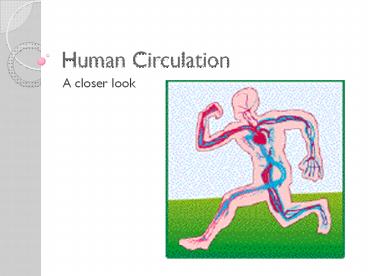Human Circulation - PowerPoint PPT Presentation
Title:
Human Circulation
Description:
Human Circulation A closer look Contents Cardiac cycle Maintenance of heartbeat Principles governing blood circulation Lymphatic system Blood composition and function ... – PowerPoint PPT presentation
Number of Views:67
Avg rating:3.0/5.0
Title: Human Circulation
1
Human Circulation
- A closer look
2
Contents
- Cardiac cycle
- Maintenance of heartbeat
- Principles governing blood circulation
- Lymphatic system
- Blood composition and function
- Cardiovascular disease
3
Cardiac cycle complete sequence of pumping and
filling
4
Electrical activity of the heart
- EKG or ECG (electrocardiogram)
- P wave - spread of electrical activity over the
atria, beginning of its contraction - QRS complex - spread of electrical activity over
the ventricles, beginning of its contraction - T wave - recovery phase of the ventricles
1 - Sinoatrial node (Pacemaker)2 -
Atrioventricular node3 - Atrioventricular Bundle
(Bundle of His)4 - Left Right Bundle
branches5 - Bundle Branches 6 - Purkinje fibers
5
Cardiac output
- Total volume of blood pumped by the left
ventricle per minute - Heart rate (HR) ? beats per minute
- Stroke volume (SV) ? mL
- Product gives the cardiac output
- Average adult
- CO HR x SV
- 70 beats/min x 75 mL/beat
- 5.25 L/min
Maximum HR 200-your age Training heart rate is
75 MHR e.g. 200-15 185 0.75 139 beats/min
20 minutes, 3x a week
6
Pulse
- Stretching of arteries as an effect of heartbeat
- Pressure waves moving the artery walls when blood
moves into aorta - Usually accurate measure of heart rate
- Normal resting pulse is 60-100 bpm
- Common pulse points
- 1. Temporal artery
- 3. Carotid artery
- 4. Brachial artery
- 5. Radial artery
7
Blood vessel structure
8
Physical principles governing blood circulation
- Blood flow velocity
- Aorta (30 cm/s)
- Capillaries (0.026 cm/s)
- Law of continuity
- Volume of flow per second must be constant
through the entire pipe - Total cross-sectional area of the pipes
delivering the fluid - Slows down in capillary beds
9
Blood pressure
- Force exerted by blood on walls of vessels
- Pressure decreases from arteries to veins
- Determined by cardiac output and peripheral
resistance by arterioles - Arterial pressure measured by a sphygmomanometer
- Systolic/Diastolic (mmHg)
- Factors
- Heart rate
- Blood volume
- Resistance of vessels
- Viscosity
10
Blood composition and function
11
(No Transcript)
12
Lymphatic System
- Functions
- Returns excess body fluid to blood
- Transports fats from intestines to blood
- Defense
- Anatomy
- Lymph nodes scattered throughout body (thymus,
spleen) - Vessels
13
Cardiovascular disease
- Cardiovascular disease (gt50 of all deaths)
- Heart attack- death of cardiac tissue due to
coronary blockage - Stroke- death of nervous tissue in brain due to
arterial blockage - Atherosclerosis arterial plaques deposit
- Arteriosclerosis plaque hardening by calcium
deposits - Hypertension high blood pressure
- Hypercholesterolemia LDL, HDL
14
Quiz Modified true or false
- Water moves from a region of lower solute
concentration to a region of higher solute
concentration through osmosis. - Vacuoles bud off the rough ER and transport
proteins to the receiving end of the Golgi
apparatus for further modification. - The sandwich model is currently the accepted
model for the plasma membrane.
15
Quiz Modified true or false
- The planaria has an open circulatory system.
- In insects, oxygen is not transported using the
circulatory system. - Interstitial fluid and blood are separate in an
earthworm. - One disadvantage of amphibian circulation is that
some mixing occurs in the heart.
16
Quiz Modified true or false
- Turtles are the only reptiles with four-chambered
hearts. - During atrial systole, the atrioventricular
valves are closed. - The T wave in an ECG corresponds to ventricular
diastole. - The stretching of arteries in response to
heartbeat is called the cardiac output.
17
Quiz Modified true or false
- Valves and skeletal muscle contraction facilitate
blood flow in veins. - Capillaries have the highest total
cross-sectional area of the three types of
vessels. - Blood pressure is equal to osmotic pressure at
the arterial end of the capillary. - When the precapillary sphincters are relaxed,
blood flows through the capillary beds.





![❤️[READ]✔️ Human Cardiovascular Control PowerPoint PPT Presentation](https://s3.amazonaws.com/images.powershow.com/10058679.th0.jpg?_=20240619076)
![❤️[READ]✔️ Human Cardiovascular Control PowerPoint PPT Presentation](https://s3.amazonaws.com/images.powershow.com/10057915.th0.jpg?_=20240618039)
![❤️[READ]✔️ Human Cardiovascular Control PowerPoint PPT Presentation](https://s3.amazonaws.com/images.powershow.com/10057068.th0.jpg?_=20240617120)


![The Top 5 Advantages of Wearing Natural Human Hair Wigs [Infographic] PowerPoint PPT Presentation](https://s3.amazonaws.com/images.powershow.com/10086179.th0.jpg?_=20240726087)




















